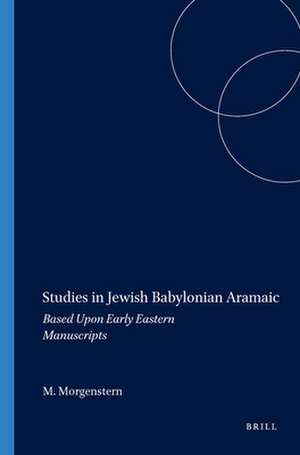Studies in Jewish Babylonian Aramaic: Based upon Early Eastern Manuscripts: Harvard Semitic Studies, cartea 62
Autor Matthew Morgensternen Limba Engleză Paperback – 31 dec 2010
Following a critical survey of the currently available scholarly tools, the book considers the rôle of the Yemenite textual and reading traditions in the study of Rabbinic Babylonian Aramaic. While some previous authorities have regarded this tradition as a primary source for grammatical study of the dialect, by comparing the data of the earliest manuscripts to the forms employed in the Yemenite traditions, the present book demonstrates that the Yemenite traditions have been subject to secondary changes. Accordingly, it is concluded here that only the early eastern manuscripts preserve the dialect in its original form.The next chapter considers the problem of linguistic variation within the corpus. It is well established that the Talmudic literature employs a wide range of alternative grammatical forms. Several explanations have been proposed for this phenomenon. Some authorities have suggested that it arises from dialectal differences, while others have proposed that it represents the use of different literary registers. An alternative explanation is that the language was altered during the course of textual transmission. This study shows that none of these explanations can account for the wide extent of the phenomenon, which is found in the best textual witnesses and in ostensibly uniform contexts. It is argued that all of proposed explanations may partially account for the interchanges but, ultimately, the lack of a literary standard leads to the use of different forms.
Syntax is often regarded as being one of the linguistic areas least affected by textual transmission. However, the early manuscripts show that Rabbinic Babylonian Aramaic employs a defined series of syntactic structures to mark the direct object. This clearly defined complimentary distribution is lost in the later textual witnesses, which use the structures interchangeably. It is thus shown that, for syntactic study, too, only a small group of textual witnesses can be regarded as reliable.
Din seria Harvard Semitic Studies
- 15%
 Preț: 611.10 lei
Preț: 611.10 lei -
 Preț: 403.43 lei
Preț: 403.43 lei -
 Preț: 343.11 lei
Preț: 343.11 lei -
 Preț: 343.11 lei
Preț: 343.11 lei -
 Preț: 348.71 lei
Preț: 348.71 lei -
 Preț: 343.11 lei
Preț: 343.11 lei -
 Preț: 343.11 lei
Preț: 343.11 lei -
 Preț: 343.11 lei
Preț: 343.11 lei -
 Preț: 343.11 lei
Preț: 343.11 lei -
 Preț: 343.11 lei
Preț: 343.11 lei -
 Preț: 306.94 lei
Preț: 306.94 lei -
 Preț: 343.11 lei
Preț: 343.11 lei -
 Preț: 343.11 lei
Preț: 343.11 lei -
 Preț: 353.10 lei
Preț: 353.10 lei -
 Preț: 343.11 lei
Preț: 343.11 lei -
 Preț: 124.57 lei
Preț: 124.57 lei - 15%
 Preț: 481.27 lei
Preț: 481.27 lei -
 Preț: 343.11 lei
Preț: 343.11 lei -
 Preț: 207.47 lei
Preț: 207.47 lei -
 Preț: 222.08 lei
Preț: 222.08 lei -
 Preț: 343.01 lei
Preț: 343.01 lei -
 Preț: 187.13 lei
Preț: 187.13 lei -
 Preț: 139.07 lei
Preț: 139.07 lei - 15%
 Preț: 363.43 lei
Preț: 363.43 lei -
 Preț: 130.22 lei
Preț: 130.22 lei -
 Preț: 306.94 lei
Preț: 306.94 lei -
 Preț: 216.33 lei
Preț: 216.33 lei -
 Preț: 147.18 lei
Preț: 147.18 lei -
 Preț: 273.82 lei
Preț: 273.82 lei -
 Preț: 310.25 lei
Preț: 310.25 lei -
 Preț: 184.73 lei
Preț: 184.73 lei -
 Preț: 306.94 lei
Preț: 306.94 lei -
 Preț: 306.94 lei
Preț: 306.94 lei -
 Preț: 318.99 lei
Preț: 318.99 lei - 15%
 Preț: 358.27 lei
Preț: 358.27 lei -
 Preț: 343.11 lei
Preț: 343.11 lei -
 Preț: 266.33 lei
Preț: 266.33 lei -
 Preț: 222.18 lei
Preț: 222.18 lei -
 Preț: 288.86 lei
Preț: 288.86 lei -
 Preț: 343.11 lei
Preț: 343.11 lei - 18%
 Preț: 553.27 lei
Preț: 553.27 lei - 15%
 Preț: 445.39 lei
Preț: 445.39 lei -
 Preț: 306.94 lei
Preț: 306.94 lei -
 Preț: 343.11 lei
Preț: 343.11 lei -
 Preț: 343.11 lei
Preț: 343.11 lei -
 Preț: 379.29 lei
Preț: 379.29 lei -
 Preț: 252.68 lei
Preț: 252.68 lei -
 Preț: 252.68 lei
Preț: 252.68 lei -
 Preț: 379.29 lei
Preț: 379.29 lei
Preț: 343.11 lei
Nou
Puncte Express: 515
Preț estimativ în valută:
65.67€ • 71.36$ • 55.20£
65.67€ • 71.36$ • 55.20£
Carte indisponibilă temporar
Doresc să fiu notificat când acest titlu va fi disponibil:
Se trimite...
Preluare comenzi: 021 569.72.76
Specificații
ISBN-13: 9781575069388
ISBN-10: 1575069385
Dimensiuni: 155 x 235 mm
Greutate: 0 kg
Editura: Brill
Colecția Brill
Seria Harvard Semitic Studies
ISBN-10: 1575069385
Dimensiuni: 155 x 235 mm
Greutate: 0 kg
Editura: Brill
Colecția Brill
Seria Harvard Semitic Studies
